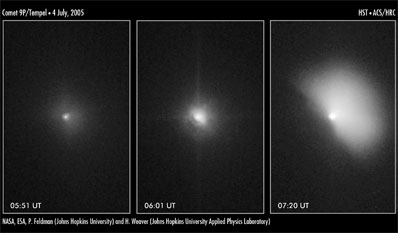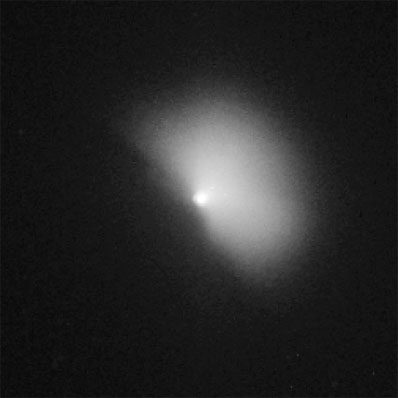

Spaceflight Now +

|

|

|

|

Premium video content for our Spaceflight Now Plus subscribers.

Mission engineering
 Deep Impact mission officials provide an engineering overview of the spacecraft's daring attempt to fire a small probe into Comet Tempel 1. This briefing occurred July 1 at JPL. (41min 04sec file) Deep Impact mission officials provide an engineering overview of the spacecraft's daring attempt to fire a small probe into Comet Tempel 1. This briefing occurred July 1 at JPL. (41min 04sec file)

 Play video: Play video:
Dial-up | Broadband

Science conference
 Scientists working on the Deep Impact mission give an update on research into Comet Tempel 1 and preview what they hope to learn with the July Fourth impact. This briefing occurred July 1 at JPL. (32min 29sec file) Scientists working on the Deep Impact mission give an update on research into Comet Tempel 1 and preview what they hope to learn with the July Fourth impact. This briefing occurred July 1 at JPL. (32min 29sec file)

 Play video: Play video:
Dial-up | Broadband

Launch of Deep Impact!
 A Boeing Delta 2 rocket blasts off from Cape Canaveral carrying NASA's comet-smashing probe called Deep Impact. This extended clip follows the mission through second stage ignition and jettison of the rocket's nose cone. (5min 37sec file) A Boeing Delta 2 rocket blasts off from Cape Canaveral carrying NASA's comet-smashing probe called Deep Impact. This extended clip follows the mission through second stage ignition and jettison of the rocket's nose cone. (5min 37sec file)
 Play video Play video

Comet science
 On the eve of Deep Impact's launch, mission scientists hold a news conference at Kennedy Space Center to discuss the comet-smashing project. (35min 17sec file) On the eve of Deep Impact's launch, mission scientists hold a news conference at Kennedy Space Center to discuss the comet-smashing project. (35min 17sec file)

 Play video: Play video:
Dial-up | Broadband

 Download audio: Download audio:
For iPod | MP3

Mission overview
 Rick Grammier, NASA's Deep Impact project manager from the Jet Propulsion Laboratory, provides a detailed overview of the spacecraft and its mission. (4min 54sec file) Rick Grammier, NASA's Deep Impact project manager from the Jet Propulsion Laboratory, provides a detailed overview of the spacecraft and its mission. (4min 54sec file)
 Play video Play video

Science preview
 Deep Impact principal investigator Michael A'Hearn explains how the comet collision will occur and what scientists hope to learn. (7min 11sec file) Deep Impact principal investigator Michael A'Hearn explains how the comet collision will occur and what scientists hope to learn. (7min 11sec file)
 Play video Play video

 Become a subscriber Become a subscriber
 More video More video

|

|

|

|

|

|

Hubble captures Deep Impact's comet collision
HUBBLE EUROPEAN SPACE AGENCY INFORMATION CENTRE
Posted: July 4, 2005
The NASA/ESA Hubble Space Telescope captured
the dramatic effects of the collision early July 4 between
a 370-kilogram projectile released by the Deep Impact
spacecraft and comet 9P/Tempel 1.

Credit: NASA, ESA, and the Hubble Hertiage Team (STScI/AURA)
Download larger image version here
Download full size image here
|
This sequence of images shows the comet before and after
the impact. The image at left shows the comet 10 minutes
before the impact. The encounter occurred at 1:52 a.m. EDT (0552 GMT).
In the middle image, captured 15 minutes after the
collision, Tempel 1 appears four times brighter than in
the pre-impact photo. Astronomers noticed that the inner
cloud of dust and gas surrounding the comet's nucleus
increased by about 200 kilometres in size. The impact
caused a brilliant flash of light and a constant increase
in the brightness of the inner cloud of dust and gas.
The Hubble telescope continued to monitor the comet,
snapping another image [at right] 62 minutes after the
encounter. In this photo, the gas and dust ejected during
the impact are expanding outward in the shape of a fan.
The fan-shaped debris is travelling at about 1,800
kilometres an hour, or twice as fast as the speed of a
commercial jet. The debris extends about 1,800 kilometres
from the nucleus.

Credit: NASA, ESA, and the Hubble Hertiage Team (STScI/AURA)
|
The potato-shaped comet is 14 kilometres wide and 4
kilometres long. Tempel 1's nucleus is too small even for
the Hubble telescope to resolve.
The visible-light images were taken by the Advanced Camera
for Surveys' High Resolution Camera.
The Hubble Space Telescope is a project of international
cooperation between ESA and NASA.

Additional coverage for subscribers:
 VIDEO:
DEEP IMPACT SMASHES INTO COMET PLAY VIDEO:
DEEP IMPACT SMASHES INTO COMET PLAY
 VIDEO:
RIDE ALONG AS THE IMPACTOR SLAMS INTO TARGET PLAY VIDEO:
RIDE ALONG AS THE IMPACTOR SLAMS INTO TARGET PLAY
 VIDEO:
NARRATION OF IMPACTOR'S FINAL IMAGES PLAY VIDEO:
NARRATION OF IMPACTOR'S FINAL IMAGES PLAY
 VIDEO:
POST-IMPACT NEWS CONFERENCE PLAY VIDEO:
POST-IMPACT NEWS CONFERENCE PLAY

 VIDEO:
"DEEP IMPACT: THE MISSION" MOVIE PLAY VIDEO:
"DEEP IMPACT: THE MISSION" MOVIE PLAY
 VIDEO:
"DIGGING OUT THE SCIENCE" PLAY VIDEO:
"DIGGING OUT THE SCIENCE" PLAY
 VIDEO:
RECAP OF IMPACTOR DEPLOY ACTIVITIES PLAY VIDEO:
RECAP OF IMPACTOR DEPLOY ACTIVITIES PLAY
 VIDEO:
PREVIEW OF TONIGHT'S ENCOUNTER TIMELINE PLAY VIDEO:
PREVIEW OF TONIGHT'S ENCOUNTER TIMELINE PLAY
 VIDEO:
LEARN MORE ABOUT THE SPACECRAFT PLAY VIDEO:
LEARN MORE ABOUT THE SPACECRAFT PLAY
 VIDEO:
SCIENCE DATA FROM COMET OUTBURSTS PLAY VIDEO:
SCIENCE DATA FROM COMET OUTBURSTS PLAY
 VIDEO:
SUNDAY MIDDAY STATUS REPORT DIAL-UP | BROADBAND 1 & 2 VIDEO:
SUNDAY MIDDAY STATUS REPORT DIAL-UP | BROADBAND 1 & 2
 VIDEO:
MISSION ENGINEERING BRIEFING DIAL-UP | BROADBAND VIDEO:
MISSION ENGINEERING BRIEFING DIAL-UP | BROADBAND
 VIDEO:
FRIDAY'S SCIENCE CONFERENCE DIAL-UP | BROADBAND VIDEO:
FRIDAY'S SCIENCE CONFERENCE DIAL-UP | BROADBAND
 MORE: DEEP IMPACT VIDEO COLLECTION! MORE: DEEP IMPACT VIDEO COLLECTION!
 SUBSCRIBE NOW SUBSCRIBE NOW

|

|

|

|
|



